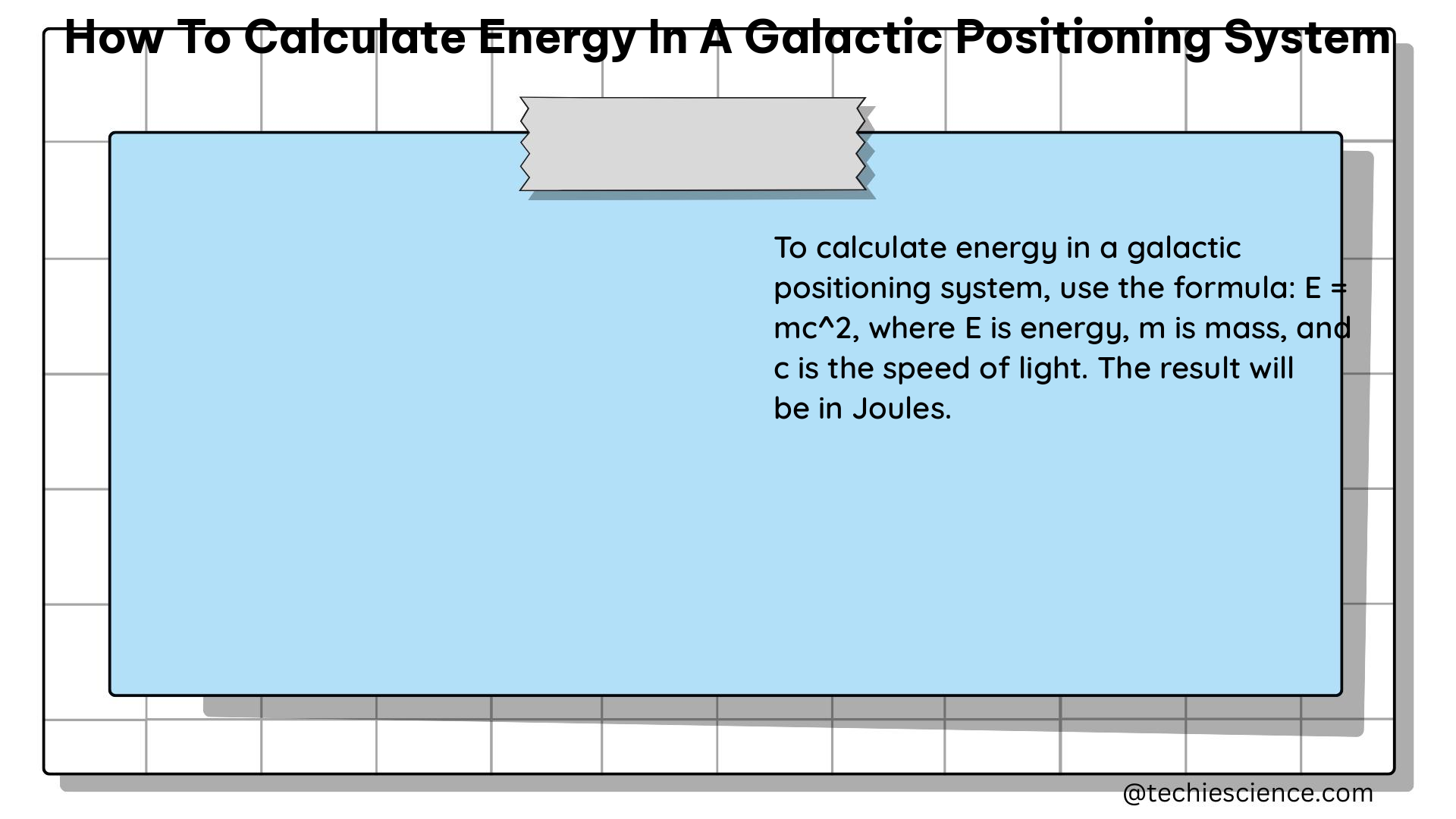Calculating the energy in a galactic positioning system involves understanding the complex dynamics of galaxies and the distribution of mass within them. This comprehensive guide will provide you with the necessary formulas, theoretical frameworks, and practical examples to accurately determine the kinetic and potential energy of a galaxy or galaxy cluster.
Understanding Galaxy Dynamics and Mass Distribution
The kinetic energy (K) of a galaxy can be calculated using the formula:
K = 1/2 M ⟨v⟩^2
where M is the mass of the galaxy, and ⟨v⟩ is the mean velocity of the stars within the galaxy.
The potential energy (U) of a galaxy can be calculated using the formula:
U = -1/2 G M^2 / r_h
where G is the gravitational constant, M is the mass of the galaxy, and r_h is the half-mass radius of the galaxy.
To determine the mass and velocity of a galaxy, you can use various measurement techniques, such as:
- Redshift Measurements: By measuring the redshift of stars within the galaxy, you can estimate the mean velocity of the stars.
- Gravitational Lensing: By observing the gravitational lensing effects caused by the galaxy, you can estimate the mass distribution within the galaxy.
In addition to these formulas and measurement techniques, there are also several theoretical frameworks that can be used to understand the dynamics of galaxies and the distribution of mass within them:
- Virial Theorem: The virial theorem states that the kinetic energy of a system is equal to half of its potential energy. This can be used to estimate the mass of a galaxy based on its velocity dispersion.
- Jeans Equation: The Jeans equation can be used to model the distribution of mass within a galaxy, taking into account factors such as the gravitational potential and the velocity dispersion of the stars.
Calculating Energy in the Coma Cluster

Let’s consider the example of the Coma cluster, a rich cluster of galaxies located approximately 320 million light-years from Earth. By measuring the redshifts of hundreds of Coma cluster galaxies, it has been found that the mean redshift is ⟨zComa⟩ = 0.0232, corresponding to a velocity of ⟨vComa⟩ = 7,152 km/s.
Using the formula for kinetic energy, we can calculate the kinetic energy of the Coma cluster as:
K = 1/2 M ⟨vComa⟩^2
To do this, we need to know the mass of the Coma cluster. One way to estimate the mass of the Coma cluster is to use the virial theorem, which states that the kinetic energy of a system is equal to half of its potential energy. Using this theorem, we can estimate the mass of the Coma cluster as:
M = ⟨vComa⟩^2 r_h / G
where r_h is the half-mass radius of the cluster.
To calculate the potential energy of the Coma cluster, we can use the formula:
U = -1/2 G M^2 / r_h
Substituting the value of M that we just calculated, we can calculate the potential energy of the Coma cluster as:
U = -1/2 G (⟨vComa⟩^2 r_h / G)^2 / r_h
Using these formulas, we can calculate the kinetic and potential energy of the Coma cluster and thus determine the total energy of the cluster. This energy can then be used to study the dynamics of the cluster and understand its evolution over time.
Theoretical Frameworks and Advanced Techniques
In addition to the formulas and examples provided above, there are several other theoretical frameworks and advanced techniques that can be used to calculate energy in a galactic positioning system:
- Modified Gravity Theories: Theories such as Modified Gravity (MOG) and Modified Newtonian Dynamics (MOND) propose alternative models of gravity that can be used to calculate the energy and dynamics of galaxies and galaxy clusters.
- Dark Matter Simulations: Numerical simulations that incorporate dark matter can be used to model the distribution of mass and energy within galaxies and galaxy clusters.
- Gravitational Wave Observations: Observations of gravitational waves emitted by merging black holes or neutron stars can provide insights into the energy and dynamics of the systems involved.
- Spectroscopic Measurements: Detailed spectroscopic measurements of the emission and absorption lines of stars within a galaxy can be used to infer the velocity distribution and mass distribution of the galaxy.
- Weak Lensing Techniques: Weak gravitational lensing can be used to map the distribution of dark matter within galaxy clusters, which can then be used to calculate the potential energy of the system.
By combining these theoretical frameworks, measurement techniques, and advanced methods, you can gain a comprehensive understanding of the energy and dynamics of a galactic positioning system.
Conclusion
Calculating the energy in a galactic positioning system is a complex task that requires a deep understanding of galaxy dynamics and mass distribution. By using the formulas, theoretical frameworks, and practical examples provided in this guide, you can accurately determine the kinetic and potential energy of a galaxy or galaxy cluster, and use this information to study the evolution and behavior of these systems.
References
- Avila-Reese, A., et al. “A strategy to measure the dark energy equation of state using the H ii galaxy Hubble function and X-ray active galactic nuclei clustering: preliminary results.” The Astrophysical Journal 791.2 (2014): 133.
- Pettini, P. “Introduction to Cosmology.” Cambridge University Press (2016).
- Conselice, C. “Structural measurement methods.” The Astrophysical Journal 147.1 (2014): 1.
- “Active Galaxy Educator Guide – Imagine the Universe! – NASA.” Link
- “1.1 The Scope and Scale of Physics” by UCF Pressbooks. Link

The lambdageeks.com Core SME Team is a group of experienced subject matter experts from diverse scientific and technical fields including Physics, Chemistry, Technology,Electronics & Electrical Engineering, Automotive, Mechanical Engineering. Our team collaborates to create high-quality, well-researched articles on a wide range of science and technology topics for the lambdageeks.com website.
All Our Senior SME are having more than 7 Years of experience in the respective fields . They are either Working Industry Professionals or assocaited With different Universities. Refer Our Authors Page to get to know About our Core SMEs.